The Capital houses myriad museums, exhibiting the classic to modern art, and science, as well as the unique and bizarre. Friday Gurgaon takes you on a trip to some of the unique and less explored museums in the Capital.
Sulabh International Museum of Toilets
We started our journey from one of the most unusual museums in the country. Located in Mahavir Enclave, just six kilometres from the Kapashera border, the Museum is dedicated to the history of toilets, and uses of human excreta in day-to-day life. It is a rare display of the evolution of toilets, and their various designs. “We can’t ignore the subject of toilets in India, as our country accumulates 900 million litres of urine and 135 million kilogrammes of faecal matter per day, with an absolutely inadequate system of its collection and disposal. That is why people in India have a constant threat of health hazards and epidemics. Keeping this in mind, I think the subject of toilets is as important as other issues such as poverty, education, and employment. I feel that a study of the history of toilets, and modern sanitary engineering, is a critical subject, and a museum is a great way to generate public interest,” says Dr. Bindeshwar Pathak, the Founder of Sulabh International Social Service Organisation, an NGO in the field of Sanitation.


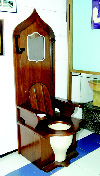

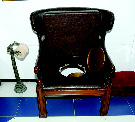
The Museum boasts of some rare collections. A map of the Indus Valley Civilisation tells that olden day Haryana gave immense importance to sanitation engineering. “Some areas in the Indus Valley Civilization reached heights of 40 feet because of the concern over sanitation and hygiene. Cities often grow upon their foundations over time, but in the Indus Valley homes were also periodically elevated, to avoid the risk of runoff from a neighbour’s sewage,” informs Mahirath, curator of the Museum.
Although the Museum has a widespread display of privies, chamber pots, toilet furniture, bidets, and water closets that have been in use since 1145, the highlight is the replica of the throne of Louis the XIII. It is believed that Kings Louis XIII and Louis the XIV used to have court sessions while using the toilet. Amazingly, King Louis the XIII had a commode under his throne. “It was a bit strange that while the king preferred privacy during his meals, he chose to ease himself publicly,” laughs out one of the curators.
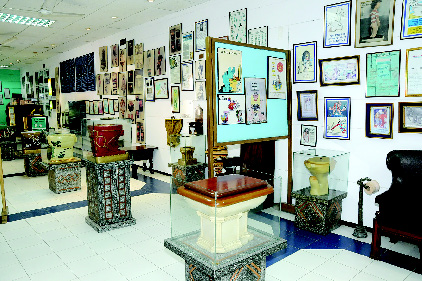
Among other priced possessions are ancient stoneware chamber pots from Britain, painted medieval urinals, and a French commode that resembles a stack of books! Modern toilets include an electric toilet, a nuclear toilet, and a toilet that operates with a remote control. “An electric toilet uses electricity to dispose the excreta, and for the cleaning and drying functions, while a nuclear toilet uses nuclear energy to do the same. A toilet that works with a remote control senses human presence, and automatically opens its top. Such toilets are generally used during the chilly winter nights in European countries, and the motive was also to save water,” explains Mr. Bhalla, Managing Director of Sulabh Museum of Toilets. The Museum also has a toilet called “Wellyoull”. Manufactured by a Japanese toilet company, “Wellyoull” measures the user’s urine-sugar level, by collecting a urine sample in a spoon that is held by a retractable mechanical arm.
After having a look at the gallery, you can move to the open-museum, and see the artefacts made with human excreta. Micheal, an artist who makes these artefacts, says “A couple of years ago a German artist visited this Museum. He designed 22 artefacts with human excreta, and sent them to various art galleries across the world. You will find one in the London Art Gallery too!” He explains that human waste is collected in a closed pit so that it gets decomposed naturally. The decomposed material is then ground into a fine powder. Later, it is mixed with fevicol, to make the artefacts.
Mahirath, who regularly spends eight hours taking visitors through the Museum, emphasises on the importance of sanitation in the country. He says that the aim of the Museum is not to establish it as a unique museum, but to spread awareness about the importance of sanitation and hygiene. Putting forth an example of how sanitation is given importance in many countries, he says, “Like in India we teach newly-wed girls to cook, Chinese brides are made to clean toilets with their hands. It depicts how much importance is given to hygiene in China. That is why they don’t suffer health epidemics caused by unhygienic conditions. Unfortunately, neither our people nor the government give value to proper sanitation. Through this Museum we hope to make people aware about this very important issue,” says Mahirath.
Bharatiya Adimjati Sevak Sangh
A 30-minute drive from Mahavir Enclave takes you to a tribal museum, “Bharatiya Adimjati Sevak Sangh”. Hidden on the side of a busy road in Central Delhi, the Museum is located adjacent to the Jhandewalan Metro Station.
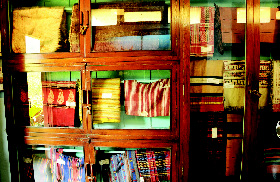
Although you might need to brave the dirty water flowing in and around the building, the Museum, that is located on the first floor, has been decently maintained. It gives you a glimpse of an extensive collection of tribal artefacts, and small and life-size dioramas, which depict the life style and setting of the tribal people in India. Bringing together culture, lifestyle, customs and beliefs of the various tribes hailing from different states, the Museum throws light on tribal heritage and their simple-yet-interesting ways of living. Stories are told through pictures, literature and the figurines. The Collection is spread across four halls and a maze of corridors, making an attempt to bring the tribal life alive to visitors. The long corridors house artefacts, that show important life events – such as festivals, acts of animal sacrifice, marriages, and polling (during elections). Moreover, there is a collection of garments used by various tribes, showcasing unique colours, weaves, and patterns. From garments, masks, jewellery, weapons, axes, stone tools, hunting gear, jars, and bundles of medicines, to musical instruments like ‘Nagaras’, flutes, and dholak, the Museum gives a perfect picture of the life of tribal communities. A life-size diorama, depicting the nuances of specific tribes, is the most interesting. The expressions on each of the figures have been carved out so well that they almost look alive. Visitors are sure to admire the simplicity of tribal life.
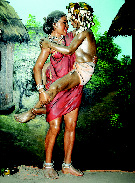
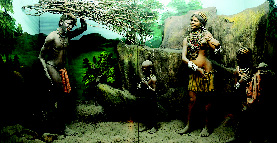
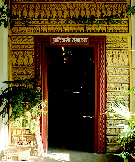
The Museum also takes you through the stories of the tribes that lived in and around Haryana, some 9,000 years ago. It showcases gigantic funeral urns of tribals, dating back to 5,000 B.C. While some are distorted, a few stand intact, with the bones found within them. What is most fascinating is miniature three-dimensional sculptures of tribal communities belonging to Madhya Pradesh. Earthenwares, reflecting the characteristic of the Iron Age, are worth a look. Within the maze of corridors and staircases is a well-maintained library. “With more than 6,000 titles, all on tribes of India, the library serves as a wonderful reference point. On week-days you will find many students studying the history of tribes here,” says a curator. A walk around the Museum also reveals some small wonders. Spread across the corridors are a few “kurinji” shrubs, that flower once every 12 years. These flowers are said to have once graced the crown of many tribals in Himachal Pradesh.
Bhai Mati Das Sati Das Museum
A Sikh museum, known as “Bhai Mati Das Sati Das Museum”, is located in the famous market of Chandni Chowk. As the market catches one’s attention first, not many people are aware that a Museum is located at the main round-about in the market.

The Museum is conceived as part of the efforts of the Shiromani Gurdwara Prabandhak Committee (SGPC). In the 1970s eminent artists such as Sohan Singh, Gurdit Singh, Bodhraj, and Amolak Singh were appointed to make paintings that revealed the Sikh history.
The Museum is named after Bhai Mati Das and Bhai Sati Das, who were brutally killed by the Mughals. A photograph of the brave Sikh Gurus, holding swords, hangs at the entrance of a picturesque building. “I have been visiting the Sheesh Ganj Gurudwara for the last 15 years, but I didn’t have a clue that here lies such a well-maintained and interesting museum. When today I heard of it I thought I would see a lot of weapons and swords, that Sikh gurus used during their struggle with the Mughals. However, I am amazed to see that the history is presented through murals ,” says Gursharan Singh, a resident of Faridabad. Breaking the popular belief that most museums in India lack a coherent and interesting display of artefacts, paintings at the Sikh museum are presented in an interesting manner. Housed in an enormous well-lit and clean complex, the Museum is divided into 60 alleys, and displays over 200 murals.
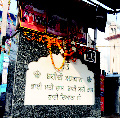
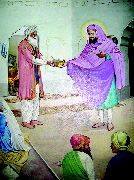
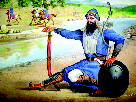
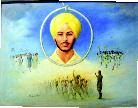
From the story of Akbar seeking Guru Amar Das’ blessing for a son, to the legendary Sikh generals capturing Delhi’s Red Fort in 1781, well-known historical events come alive in the Museum. The curator, Bhai Charan Singh, informs us about Sikh history. He showcases an interesting painting, wherein the founder of Sikhism, Guru Nanak, reads a beautiful composition on 'woman', in a gathering of men. It reflects the equal status given to men and women by the Sikh guru.
While a rare painting depicts the Sikh militants holding a durbar after their victory, the most interesting is a painting that shows Sri Lankan dancers, who were sent by their king to entice Guru Nanak. Later these dancers became his followers. Murals not only reflect the sacrifice of the nine Sikh Gurus, but also showcase how Sikh women at that time participated equally in the wars. The Museum also reflects the history of Delhi. While a mural depicts the massive construction at Chandni Chowk, other paintings showcase how small pox hit Delhi, and dead bodies lay across the City. Not just history, the Museum also showcases the contribution of the Sikh community to the world in the 21st century. A mural depicts that in 2009 a Sikh organisation made a world record by collecting 18,207 units of blood in 16 hours, during a massive blood donation camp organised on the occasion of Hola Mohalla at Anandpur, Punjab. Paintings have been added to the collection over time.
National Crafts Museum
After enjoying the serenity at the Sikh museum, we brave the crowded streets of Chandni Chowk to head to our next destination – National Crafts Museum, situated at Pragati Maidan.
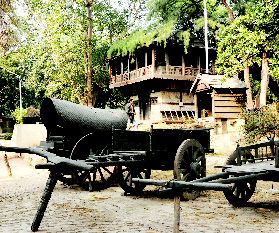
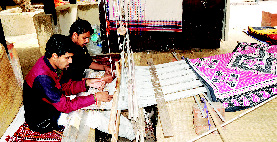
From modern audio-visual rooms, showcasing the history of craftsmanship in the country, to actual physical displays and regional musicians, this place promises to be different from the standard museum experience. With the collection of 20,000 items of folk and tribal arts, crafts, and textiles, the Museum was designed by a renowned architect, Charles Correa, in 1956. The Museum has several open and semi-open passages, that are covered with sloping, tiled roofs, and lined with old carved wooden ‘jharokhas’. A walk through the Village Complex, spread over an area of about four acres, helps in exploring village dwellings, courtyards, and shrines from various states – such as Arunachal Pradesh, Himachal Pradesh, Madhya Pradesh, Gujarat, Rajasthan, West Bengal, Tamil Nadu, Orissa, and the Andaman & Nicobar Islands. Courtyards having domed pigeon houses, terracotta shrines dedicated to basil plants, massive temple chariots, and walls adorned with magnificent paintings made by tribal and rural artists, make it a heaven for a photographer. Shikha, a curator, says, “Thanks to its vast collection and good management, this Museum has drawn many leading personalities. The First Lady of the US, Michelle Obama, on her visit to the Capital, insisted on Barack Obama to visit the National Crafts Museum. Michelle said that she was amazed to have a glimpse of the varied skills of Indian artisans.”


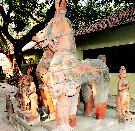
There are also numerous shops that sell handicrafts within the premise. You can also find miniatures of many famous buildings of Delhi, and the Taj Mahal, and the edifices of cultural heritage from other parts of India.
The Museum is not confined to just preserving historic artefacts. It has become a centre for intellectual activities. It is emerging as a premier research centre for archaeologists, historians, and academicians. Documentary film making, film festivals, art exhibitions, folk dance competitions, debates, painting competitions, community based and leadership training programmes and special educational and cultural classes for children are featured in the Museum’s busy curriculum. “We have been called an active museum. Last year, we held a unique year-long celebration of Tagore’s birth anniversary. This year we are planning to celebrate 100 years of Indian Cinema,” says Shikha.
Read More...